In cold process soap making, you'll want your oils and lye solution to reach 120-130°F for ideal results. During saponification, temperatures naturally rise to around 200°F as the chemical reaction generates heat. For vibrant colors, aim for 131-160°F to encourage gel phase, while cooler temperatures (100-110°F) create pastel tones. Keep your lye and oils within 10 degrees of each other for consistent, high-quality soap. The right temperature control transforms your soap from good to exceptional.
What Temperature Should Your Soap Making Process Reach?
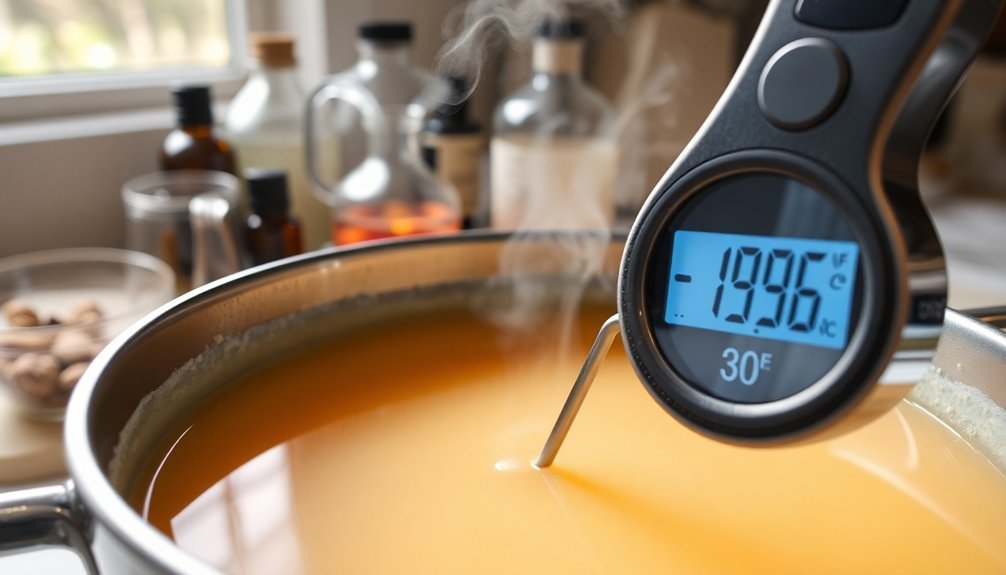
Why does temperature matter so much in soap making? Temperature directly impacts your saponification process, affecting everything from how quickly your soap sets to its final appearance.
For peak results, keep both lye temperatures and soap making oils within the 120-130°F range. This ideal temperature range guarantees proper chemical reactions while helping prevent false trace when oils and lye combine.
Want vibrant colors? Aim for higher temperatures (131-160°F) to encourage gel phase. For more pastel results, lower temperatures (100-110°F) will keep your soap from gelling.
Remember to monitor temperatures throughout the process, keeping your lye and oils within 10 degrees of each other. Most soap recipes work best when you maintain consistent heat levels, as temperature fluctuations can lead to thick trace or separation issues.
Ideal Temperature Ranges for Cold Process Soap Making
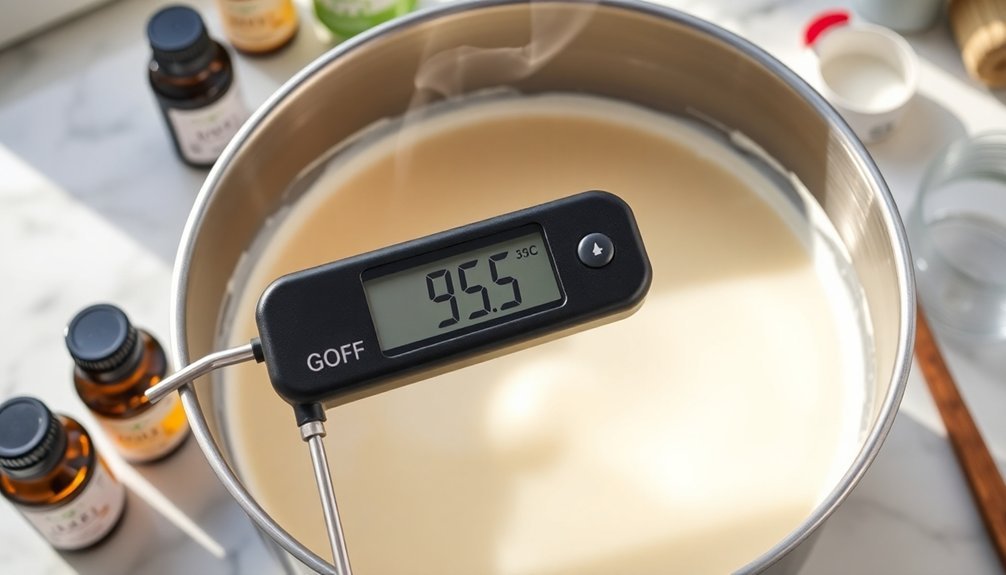
Cold process soap making demands precise temperature control for successful results. The ideal temperature range for both your oils and lye solution typically falls between 120-130°F, creating favorable conditions for saponification to occur properly.
At this range, your oils remain clear without cloudiness that indicates solidified fatty acids, which can lead to false trace issues in your soap.
If you're working with heat-sensitive ingredients like milk or certain fragrance oils, consider cooler temperatures (100-110°F) to prevent scorching and preserve delicate components.
Alternatively, higher temperatures (131-160°F) promote gel phase, which enhances color vibrancy and reduces soda ash formation on your finished soap.
Your specific recipe and desired end result will determine which temperature range within this spectrum will serve you best.
Understanding Heat Generation During Saponification
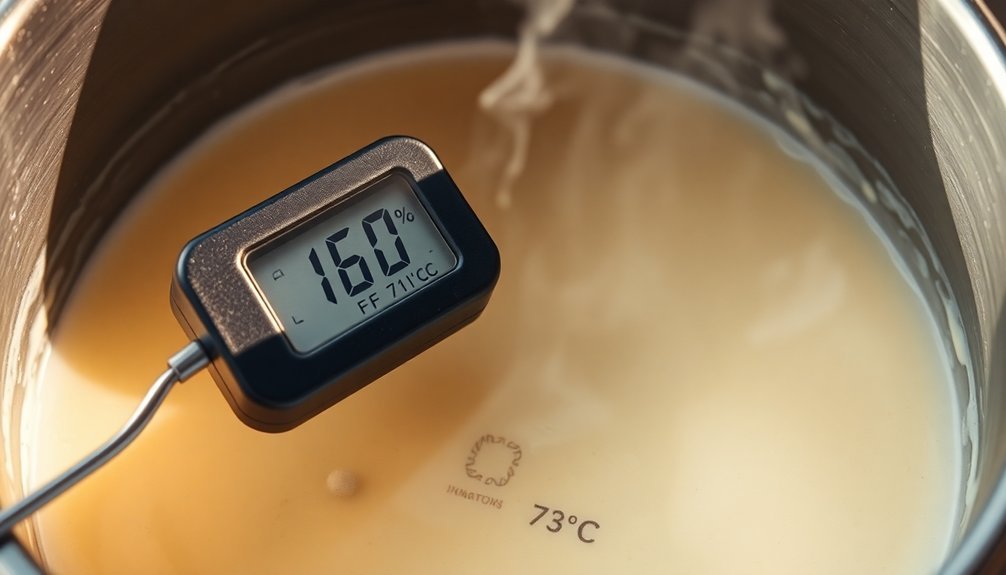
During soap making, you'll experience firsthand how saponification generates significant heat as lye and oils react chemically together.
This exothermic reaction can raise your soap mixture's temperature to approximately 200°F, creating enough thermal energy to transform your ingredients into soap.
Understanding these peak temperature ranges helps you manage the process effectively, preventing issues like false trace while allowing beneficial phases like gel that enhance your final product's appearance.
Exothermic Reaction Basics
At the heart of every soap-making process lies an exothermic reaction that transforms your raw ingredients into soap. When you combine lye with oils, the saponification process generates heat naturally, raising the temperature of your mixture considerably. You'll notice this reaction immediately as your soap batter begins to warm.
| Phase | Temperature Range | What's Happening |
|---|---|---|
| Lye Solution | Up to 200°F | Initial exothermic reaction |
| Cooling Period | 120-130°F | Preparation for mixing with oils |
| Trace Stage | 100-110°F | Mixture thickens properly |
| Too Cold | Below 90°F | Risk of false trace |
| Too Hot | Above 160°F | Potential soap defects develop |
Monitoring temperature throughout your process is vital. You'll benefit from the heat when melting solid oils, but excessive temperatures can damage your soap's appearance and texture.
Peak Temperature Ranges
Now that you understand the basic exothermic nature of soap making, let's examine the specific temperature peaks you'll encounter throughout the process.
Your lye solution can reach up to 200°F during preparation due to the intense chemical reaction with water. However, the ideal temperature for combining your lye and oils falls between 120-130°F—this sweet spot helps avoid false trace while ensuring proper saponification.
During curing, your soap's peak temperature plays an essential role in quality. Proper insulating encourages the gel phase, which enhances color vibrancy and creates a shinier finished product.
In colder environments, you'll need additional heat transfer methods to maintain adequate temperatures. Be careful though—overheating can cause wrinkly textures or even soap volcanoes.
Monitoring these temperature ranges carefully will lead to consistent, high-quality soap every time.
The Role of Gel Phase in Temperature Management
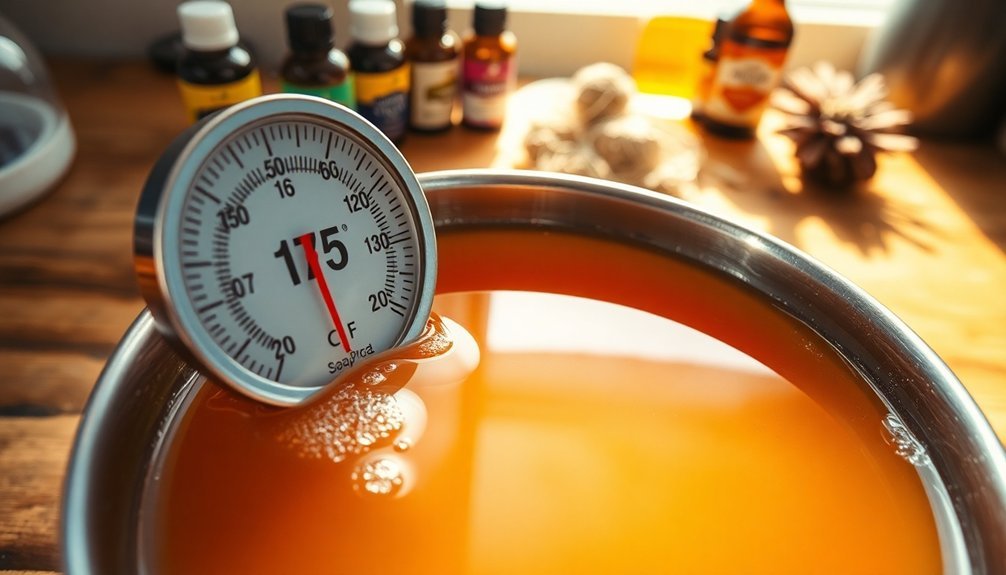
You'll reveal vibrant colors and glossy finishes by intentionally managing your soap's gel phase through proper insulation techniques, typically maintaining temperatures around 180°F.
Wrapping your soap loaf in towels or using insulated molds helps control heat retention, with loaf molds providing better insulation than cavity molds, especially in cooler environments.
Monitor your soap during this critical phase by watching for translucent, gelatinous appearance in the center that spreads outward—a sign you're successfully capturing the benefits of faster unmolding and reduced soda ash formation.
Heat Activation Benefits
While many beginners fear high temperatures in soap making, understanding the gel phase can transform your approach to heat management. Instead of avoiding heat, you can use insulation to intentionally promote the gel phase, allowing temperatures to reach up to 180°F during saponification.
This controlled heat activation delivers several benefits to your soap bars. You'll notice more vibrant colors and a glossy, professional finish that makes your creations stand out. Additionally, gelled soap unmolds faster and resists soda ash formation that can dull your soap's appearance.
Your choice of mold matters—loaf molds retain heat better than cavity molds, making them ideal for achieving gel phase. You can also leverage the additional heat generated by certain fragrance oils, especially spicy ones, to further enhance the saponification process.
Controlling Insulation Methods
Three strategic insulation methods give you precise control over the gel phase in soapmaking. When your lye and oils reach 120-130°F, insulate using a drawer, box, or heating pad to encourage temperatures up to 180°F during saponification.
Your mold choice greatly impacts heat retention—loaf molds maintain higher temperatures than cavity molds, directly affecting your soap's final appearance.
- Feel the excitement as your soap transforms into a glossy, gelatinous masterpiece after just 30 minutes of proper insulation
- Experience the satisfaction of achieving vibrant, eye-catching colors that only gel phase can provide
- Enjoy the confidence of knowing exactly when to add more insulation by monitoring your soap's warmth
- Master the art of rapid cooling when needed—saving your creation from overheating disasters
Gel Phase Monitoring
Successful soapmakers recognize that gel phase represents the critical temperature peak in your soap's transformation journey.
During saponification, temperatures can soar to 180°F, enhancing your soap's vibrancy and appearance.
After initially insulating your batch for 30 minutes, check for warmth and a gelatinous texture—these are telltale signs of proper gel phase.
If your soap feels cool or shows no gelling indications, add more insulation with a towel or heating pad to encourage the process.
Monitor your batch carefully, as overheating brings unwanted consequences.
Wrinkly surfaces or soap expanding beyond your mold signals excessive temperatures.
Should you notice these warning signs, you can quickly cool your soap by placing it in the freezer, preventing texture damage.
This balance between promoting and controlling gel phase guarantees your finished bars achieve superior quality.
Monitoring Tools and Techniques for Soap Temperature
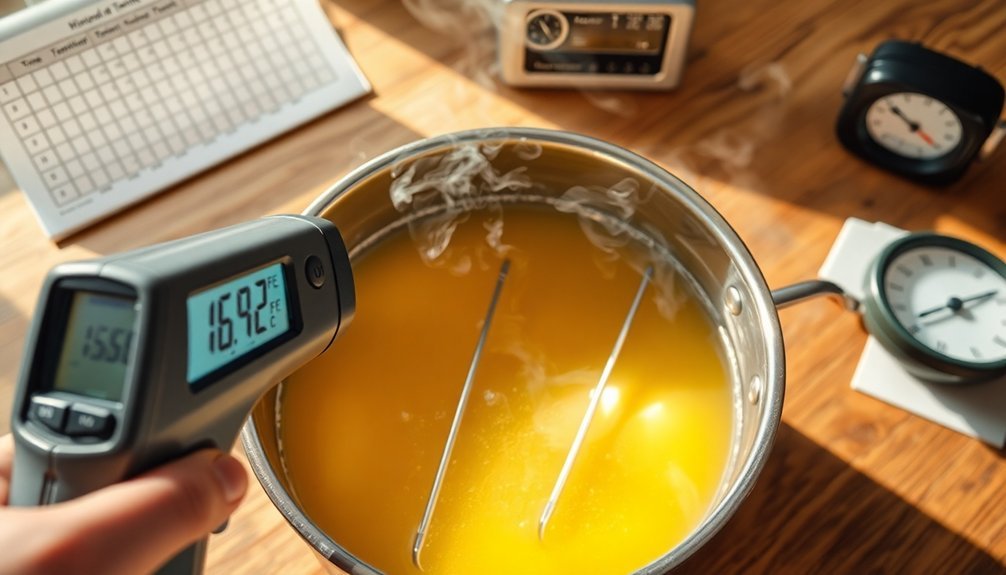
Accurate temperature measurement stands as the foundation of successful soap making. A digital laser thermometer is your most reliable ally in monitoring both lye and oils throughout the process.
Keep both components within 10 degrees of each other, ideally between 120-130°F, to prevent false trace issues and guarantee proper saponification.
- Feel the satisfaction of perfectly melted oils combining with your precisely measured lye solution
- Experience the confidence of knowing exactly when your mixture has reached ideal temperature
- Enjoy the peace of mind that comes from preventing costly mistakes through vigilant monitoring
- Discover the joy of mastering the heat transfer method, transforming your soap making efficiency
Remember to check temperatures periodically, especially after combining ingredients, as temperature management directly affects your soap's quality and appearance.
Temperature Adjustments for Different Soap Recipes
While mastering the general temperature guidelines provides a foundation for soap making, each recipe demands its own thermal consideration based on ingredients and desired outcomes.
When working with high liquid oils, you'll find that room temperature often suffices, as their low melting point allows for easier blending. In contrast, solid oils require heating to 120-130°F to achieve proper incorporation.
For milk-based soaps, opt for cooler temperatures (100-110°F) to prevent scorching of natural sugars. If you're using fragrance oils that generate heat, cooler lye solution temperatures help prevent accelerated trace occurs.
For vibrant colors or when incorporating beeswax, higher temperatures (131-160°F) encourage gel phase and reduce soda ash formation.
Remember that adjusting your lye solution to be slightly cooler than your oils can provide better control over the soap making process.
Troubleshooting Temperature-Related Soap Making Issues
Even the most carefully calibrated temperatures can sometimes lead to unexpected challenges in your soap making process. When your soap overheats, it can enter gel phase too quickly, causing soap volcanoes or alien brain formation. You can prevent this by monitoring temperature closely and placing your mold in the freezer if necessary.
Keeping your lye and oils within 10 degrees of each other during mixing helps prevent uneven saponification and false trace issues.
- The frustrating moment when you discover soda ash on your beautiful soap from oils being too cold
- The panic of watching your carefully crafted soap turn into a volcanic eruption from excessive heat
- The satisfaction of rescuing an overheating batch just in time
- The relief when your proper temperature management results in perfect saponification
Frequently Asked Questions
What Is the Temperature Range for Soap Making?
For soap making, you'll want to maintain temperatures between 90-130°F (32-54°C). Cold process works best at 120-130°F, while cooler temps (100-110°F) are better for recipes with milk or delicate fragrance oils.
What Happens if Cold Process Soap Gets Too Hot?
If your cold process soap gets too hot, it'll enter gel phase, causing alien brains, volcanoes, or glycerin rivers. You'll notice wrinkly texture or soap rising. Quick freezing can help prevent further damage.
What Is the Optimum Temperature for Saponification?
Your optimum saponification temperature is between 120°F and 130°F for both lye and oils. You'll want to keep them within 10 degrees of each other to guarantee effective mixing and prevent false trace issues.
What Happens if You Use Cold Process Soap Too Soon?
Using cold process soap too soon can cause false trace, unmolding problems, dull colors, harsh skin reactions, and soda ash formation. You'll risk incomplete saponification, leaving your bars crumbly, irritating, and aesthetically disappointing.
In Summary
You'll find success in soap making when you maintain proper temperatures—around 110-130°F for oils and 100-120°F for lye. Don't ignore the importance of monitoring your batch through saponification, as temperatures will naturally rise. Adjust as needed for different additives and formulations. With practice, you'll develop an intuition for temperature management that transforms your soap making from unpredictable to consistently beautiful.





Leave a Reply